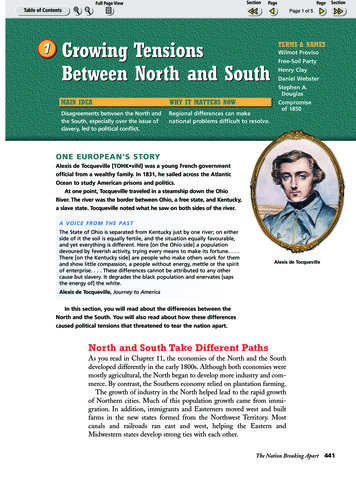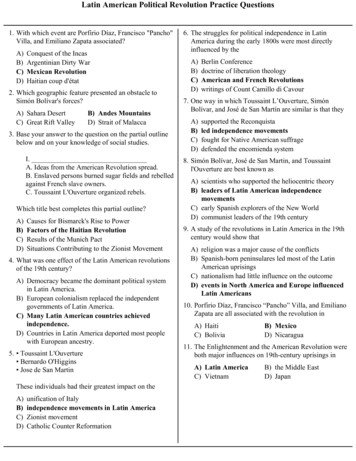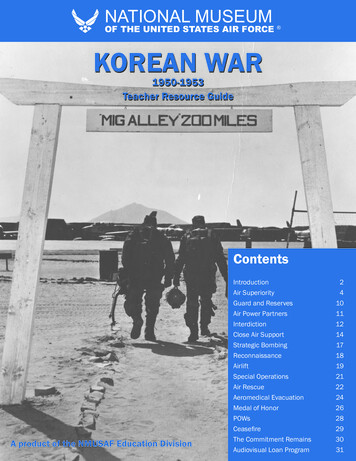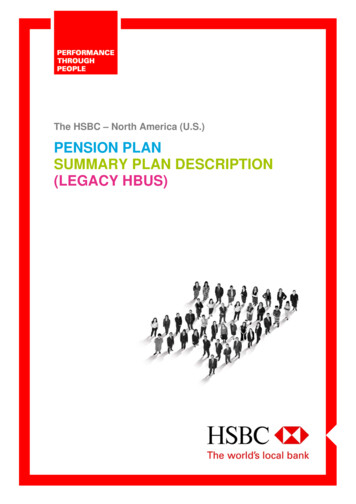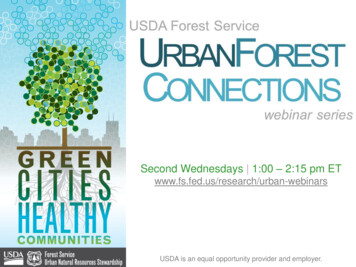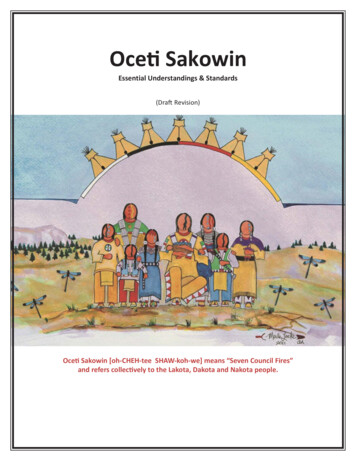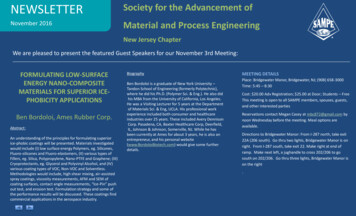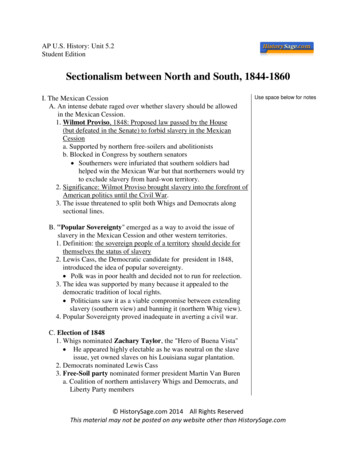
Transcription
AP U.S. History: Unit 5.2Student EditionSectionalism between North and South, 1844-1860I. The Mexican CessionA. An intense debate raged over whether slavery should be allowedin the Mexican Cession.1. Wilmot Proviso, 1848: Proposed law passed by the House(but defeated in the Senate) to forbid slavery in the MexicanCessiona. Supported by northern free-soilers and abolitionistsb. Blocked in Congress by southern senators Southerners were infuriated that southern soldiers hadhelped win the Mexican War but that northerners would tryto exclude slavery from hard-won territory.2. Significance: Wilmot Proviso brought slavery into the forefront ofAmerican politics until the Civil War.3. The issue threatened to split both Whigs and Democrats alongsectional lines.Use space below for notesB. "Popular Sovereignty" emerged as a way to avoid the issue ofslavery in the Mexican Cession and other western territories.1. Definition: the sovereign people of a territory should decide forthemselves the status of slavery2. Lewis Cass, the Democratic candidate for president in 1848,introduced the idea of popular sovereignty. Polk was in poor health and decided not to run for reelection.3. The idea was supported by many because it appealed to thedemocratic tradition of local rights. Politicians saw it as a viable compromise between extendingslavery (southern view) and banning it (northern Whig view).4. Popular Sovereignty proved inadequate in averting a civil war.C. Election of 18481. Whigs nominated Zachary Taylor, the "Hero of Buena Vista" He appeared highly electable as he was neutral on the slaveissue, yet owned slaves on his Louisiana sugar plantation.2. Democrats nominated Lewis Cass3. Free-Soil party nominated former president Martin Van Burena. Coalition of northern antislavery Whigs and Democrats, andLiberty Party members HistorySage.com 2014 All Rights ReservedThis material may not be posted on any website other than HistorySage.com
HistorySage.com APUSH Lecture NotesUnit 5.2: Sectionalism, 1844-1860b. Supported the Wilmot Proviso; against slavery in the territories "Free soil, free speech, free labor, and free men."c. Sought federal aid for internal improvements and free gov’thomesteads for settlers in the Westd. Party foreshadowed emergence of the Republican party 6 yearslater4. Result: Taylor 163, Cass 127, Van Buren 0 Free-Soilers won no states and did not impact the outcome ofthe election.II. Sectional issues by 1850 deeply divided the nation.A. California statehood threatened the sectional balance1. Gold Rush: Gold was discovered in 1848 at Sutter’s Mill(Sacramento)a. Prospectors became known as "forty-eighters" Numbers were relatively small compared to massmigration the following yearb. 1849, masses of “49ers” came to northern Californiac. Gold essentially paved the way for rapid economic growth inCalifornia. San Francisco sprouted up in just months. Northern California became the state’s main populationcenter. By 1850, California’s population had grown from 14,000to over 100,000.2. California drafted a constitution in 1849 that excluded slaveryand asked Congress for admission as a state.a. CA would bypass territorial phase, blocking southern hopesto spread slavery there.b. Southerners opposed CA statehood; saw another free state asa threat3. When CA applied for statehood, southern "fire-eaters" threatenedsecession.B. New Mexico and Utah territories also leaned toward freestate status. Along with California, the number of free states would tipdecisively in favor of the North.C. The Underground Railroad and the fugitive slave issue infuriatedsoutherners. (see Unit 4.5)1. The issue seemed as further proof for southerners that theNorth did not respect Constitutional protections for slavery.2. Significance: by 1850 southerners demanded a new, strongerfugitive-slave law; the existing law dating back to the 1790s HistorySage.com 2014 All Rights ReservedPage 2
HistorySage.com APUSH Lecture NotesUnit 5.2: Sectionalism, 1844-1860was weak.a. About 1,000 runaways successfully escaped per year. Small in number; more slaves bought their freedom thanran awayb. Some northern states (e.g., Pennsylvania) failed to providecooperation.c. Southerners blamed abolitionists; claimed they operatedoutside the lawD. Texas claimed a vast disputed area east of the Rio Grande.1. Included part of eastern New Mexico, Colorado, Kansas andOklahoma2. TX also threatened to seize Santa Fe, New Mexico’s largestcity.3. The federal government did not accept Texas’ land claims.4. President Taylor threatened to send troops to Texas if it movedon any of the territories in question.E. Northerners demanded the abolition of slavery and slave auctions inWashington, D.C. Many were embarrassed that the nation’s capital containedthousands of slaves while slave auctions occurred within sightof the Capitol Building and foreign visitors.F. Nashville Convention of southern fire-eaters was due to convene inJune 1850 for the purpose of discussing southern rights andsecession should California be admitted into the Union. Many saw this as an ominous sign of disunion if no compromisewas reached.III. Compromise of 1850A. Henry Clay initiated his third and final great compromise.1. Proposed that the North should pass a more effective fugitiveslave law2. John C. Calhoun (dying of TB) rejected Clay’s position asinadequate.a. He demanded that abolitionists leave slavery alone, that theNorth return runaway slaves, and that the political balancebe restored.b. His scheme included having two presidents, one from theNorth and one from the South (Concurrent Majority).3. Daniel Webster supported Clay (famous "7th of Marchspeech")a. Urged reasonable concessions to the South, including atough fugitive law. HistorySage.com 2014 All Rights ReservedPage 3
HistorySage.com APUSH Lecture NotesUnit 5.2: Sectionalism, 1844-1860b. Opposed Congress legislating in the territories since theclimate was not conducive for growing cotton. Ironically, CA became a leading cotton producer.c. Significance: turned the North toward compromised. Abolitionists branded Webster a traitor; meanwhile,Webster detested abolitionists as a threat to national unity.e. William H. Seward ("Higher Law" Seward) a youngernorthern radical was opposed to granting concessions to theSouth. Stated Christian legislators must obey God’s moral law aswell as man’s law Claimed slavery shouldn't be allowed in the westernterritories due to a "higher law" than the ConstitutionB. The threat of war persisted.1. President Taylor, swayed by Seward, seemed againstconcessions to the South.2. Taylor was determined to send troops to Texas if Texansattacked New Mexico; this would have started a civil war.3. President Taylor died of gastroenteritis on July 9, 1850 and wassucceeded by Vice President Millard Fillmore who supportedthe compromise.4. Senator Stephen Douglas was the most important in gettingthe bill passed through Congress.C. "Compromise of 1850"1. California was admitted as a free state.2. Slave trade was abolished in the District of Columbia3. Popular sovereignty in the Mexican Cession: New Mexico andUtah territories.4. More stringent Fugitive Slave Law than the 1793 law5. Texas received 10 million from the federal gov’t forsurrendering its claim to the disputed territory in New Mexico.Memory Aid for Compromise of 1850: “PopFACT”Popular Sovereignty in Mexican CessionFugitive Slave LawAbolition of slave trade in Washington, D.C.California admitted as a stateTexas given 10 million for disputed Mexican territory. HistorySage.com 2014 All Rights ReservedPage 4
HistorySage.com APUSH Lecture NotesUnit 5.2: Sectionalism, 1844-1860D. Results1. Fugitive Slave Law became the single most important frictionalissue between North and South in the early 1850sa. The Fugitive slave law may have been a major blunder by theSouth as northerners saw it as appalling. Abolitionist movement was given a big boost. Slaves could not testify on their own behalf and were denieda jury trial. Heavy fines and jail sentences for those who aided andabetted runawaysb. Some states refused to accept the Fugitive Slave Law. Massachusetts made it illegal to enforce it (seen by theSouth as a move toward nullification) Other states passed "personal liberty laws" denying localjails to federal officials.c. Ableman v. Booth, 1859: Supreme Court upheld the FugitiveSlave Law.2. The North got the better deal.a. California tipped the Senate in favor of the Northb. Popular sovereignty in the New Mexico and Utah desertprobably favored the North.c. The 10 million given to Texas was a modest sum while thenew area it had claimed was almost certain to be free.d. Halt of the slave trade in Washington, D.C. was a step towardemancipating it.3. Some historians argue that the Compromise of 1850 won theCivil War for the North.a. The North gained ten years to expand economically andgain sentiment for the Union cause. Many northerners were unwilling to go to war in 1850 forthe Union cause.b. Controversy in the 1850s (especially the Kansas Nebraska Actand its aftermath) galvanized northerners to resist secession.IV. Election of 1852A. Democrats nominated Franklin Pierce (from New Hampshire)1. He was sympathetic to Southern views and acceptable to theslavery wing of the party.2. His campaign came out in favor of the Compromise of 1850.B. Whigs nominated General Winfield Scott but the party was fatallysplit1. Antislaveryites supported Scott but hated his support of theFugitive Slave Law.2. Southern Whigs supported the Fugitive Slave Law but questionedScott's willingness to enforce the Compromise of 1850. HistorySage.com 2014 All Rights ReservedPage 5
HistorySage.com APUSH Lecture NotesUnit 5.2: Sectionalism, 1844-1860C. Pierce defeated Scott 254 - 42D. Significance: Marked the effective end of Whig party With the Whig party shattered by sectionalism, only theDemocratic party remained as a truly national party. (When itcracked in 1860, the country plunged toward civil war.)V. Expansionism under President PierceA. “Young America”: Pierce sought to extend "Manifest Destiny"overseas.1. Some leaders, especially Southerners, sought to gain landoverseas for the expansion of slavery (especially in Cuba).2. American expansion overseas would be realized as a result of theSpanish-American War in 1898 but NOT in the 1850s.B. Nicaragua1. In the late 1840s the U.S. and Britain sought control of theCentral American isthmus (especially Nicaragua) for a possiblecanal that would connect the Atlantic and Pacific oceans.2. War in Nicaragua seemed inevitable as Britain challenged theMonroe Doctrine.3. Clayton-Bulwer Treaty (1850): U.S. and Britain agreed thatneither side would build and monopolize a new canal without theother's consent.4. Walker Expedition (1855-57)a. Journalist and physician James Walker sailed with 60 men toNicaragua in 1855 and, with local support (and someAmericans), took control of the country.b. President Pierce briefly recognized Walker’s regime, whichreinstituted slavery to the delight of U.S. southern businessmenc. A coalition of Central American armies defeated Walker’sregime in late 1856 and Walker was forced to return to the U.S.C. Cuba1. Polk had earlier offered Spain 100 million for Cuba but Spainrefused.a. Southerners were eager to create new states out of Cuba torestore the political balance.b. Some southerners had invested in sugar plantations in Cuba.2. 1850-51: two expeditions by private southern troops into Cubafailed.3. 1854, Spain seized U.S. steamer Black Warrior on a technicality. Southerners demanded a war with Spain to seize Cuba.4. Ostend Manifesto, 1854a. U.S. secretly demanded Cuba for 130 million.b. If Spain refused, the U.S. would take it by force. HistorySage.com 2014 All Rights ReservedPage 6
HistorySage.com APUSH Lecture NotesUnit 5.2: Sectionalism, 1844-1860c. Plan backfired: angry northern free-soilers blocked it; claimedit was a “slaveholder’s plot”D. Gadsden Purchase (1853)1. U.S. sought a transcontinental railroad to connect California andOregon to the rest of the country Sea routes from the east coast were impractical and left thewest coast militarily vulnerable.2. Issue in Congress: should the future transcontinental railroadroute run through the North or South?a. Too costly to build two railroads simultaneouslyb. Railroad would provide enormous benefits to the regionreceiving it.c. Best route seemed to be a southern route partly below theMexican border so as to circumvent the Rocky mountains.3. 1853, the U.S. purchased the Mesilla Valley (in southern NewMexico and Arizona) from Mexico for 10 million. After the Gadsden Purchase (1854) the U.S. border belowCanada and above Mexico was complete.4. Result:a. South now had the advantage regarding the railroad. Proposed route ran through states or organized territoryunlike Nebraska in the North; Rocky Mountains were farlower on the southern route.b. North rushed to organize Nebraska territory but Southernersblocked it.E. Asia1. The acquisition of California and Oregon in the 1840s gave theU.S. access to the Pacific.2. The U.S. signed trade agreements with China.3. 1853, Pierce sent Commodore Matthew Perry on a secondexpedition to force Japan to open trade with the U.S.a. Fillmore had originally ordered the expedition in 1852 to freeU.S. whaling ships that were not allowed to leave Japan.b. Although Japan opened trade and began to industrialize, theevent signaled the beginning of poor U.S.-Japan relations thatwould lead to Japan’s attack on Pearl Harbor in 1941.VI. The Kansas-Nebraska Act (1854): most important short-term causeof the Civil WarA. Stephen Douglas proposed splitting the Nebraska Territory in two:Nebraska and Kansas1. In effect, this was a northern response to the Gadsden Purchase.2. Motive: Douglas sought to make his home state of Illinois the HistorySage.com 2014 All Rights ReservedPage 7
HistorySage.com APUSH Lecture NotesUnit 5.2: Sectionalism, 1844-1860eastern terminus for the transcontinental railroad.3. Kansas would presumably become a slave state; Nebraska wouldbe free.4. The slavery issue would be based on popular sovereignty.5. However, Kansas was above the 36 30’ line which prohibitedslavery north of it. Solution: repeal the Missouri Compromise of 18206. Southerners fully supported it and pushed Pierce to support it.B. The bill passed in 1854 as Douglas guided it through Congress.1. Northerners were shocked as they saw the Compromise of 1820as a sacred pacta. Many northerners refused to honor the Fugitive Slave Law.b. The antislavery movement grew significantly.c. The North became unwilling to compromise on future issues.2. Effectively wrecked the Compromises of 1820 and 1850 Douglas miscalculated the adverse impact of the law on theNorth.C. Birth of the Republican party1. Republican party formed in response to the Kansas-Nebraska Act.a. Included Whigs, northern Democrats, Free-Soilers, andKnow-Nothingsb. Abraham Lincoln came out of political retirement and ran forthe Illinois Senate as a direct response to Kansas-Nebraska.2. Emerged as the nation’s second major political party quickly andovercame strong competition from the Know-Nothings3. The Republican party was not allowed in the South.VII. "Bleeding Kansas"A. New England Emigrant Aid Company1. Sent 2,000 men into Kansas to stop slavery from spreading there.2. Many came armed with breach loading rifles ("Beecher’sBibles")B. Southerners were furious that the North betrayed the spirit of theKansas-Nebraska Act.1. The law implied that Kansas would become slave and Nebraskawould remain free.2. Armed southerners came into Kansas to resist northerners.3. Ironically, only 2 slaves lived in Kansas in 1860.C. 1855, an election was held in Kansas for its first territoriallegislature1. Proslavery "border ruffians" from Missouri poured into Kansas: HistorySage.com 2014 All Rights ReservedPage 8
HistorySage.com APUSH Lecture NotesUnit 5.2: Sectionalism, 1844-1860"vote early and vote often!"2. Southerners won the election and created a puppet government.3. Free-soilers ignored the bogus election and created its own gov'tin Topeka.D. 1856, a proslavery gang attacked and burned part of the free-soiltown of Lawrence, Kansas.E. The caning of Charles Sumner (May 22, 1856)1. Sumner, an abolitionist Senator from Massachusetts, gave aninflammatory speech— "Crime Against Kansas"—where hecondemned pro-slave southerners and insulted one of its senators2. South Carolina Congressman Preston Brooks retaliated bysavagely beating Sumner with an 11-oz gold-headed cane. House of Representatives didn't have the votes to expel Brooksbut he resigned anyway and was unanimously reelected bySouth Carolina (although he died several months later).3. Significance: The beating demonstrated the hatred brewing inCongress between the North and the South.F. Pottawatomie Massacre , May 24-25, 18561. John Brown and his sons slaughtered 5 men in revenge for theattack on Lawrence (and the caning of Sumner)2. Brown an extreme abolitionist; saw himself as doing God's work.3. Brown escaped justice.4. A mini-civil war began in Kansas in 1856 that continued throughthe U.S. Civil War.G. Lecompton Constitution (1857)1. Kansas applied for statehood based on popular sovereignty.2. Southerners in control drafted a pro-slavery constitution.a. People voted for the constitution either with or with or withoutslavery.b. If people voted “no” on slavery, rights of slaveholders currentlyin Kansas would be protected nonetheless.3. Free-soilers again refused to vote for a southern-dominatedconstitution.4. Slave supporters approved the constitution with slavery late in1857.5. President Buchanan supported the Lecompton Constitution.6. Senator Douglas led the opposition to it.7. Compromise: Lecompton Constitution was sent back to Kansasfor another vote but pro-slavery Kansas rejected the proposal8. Result: Free-soilers victorious; Kansas was denied statehood until1861 (after Southern secession) when it entered as a free state. HistorySage.com 2014 All Rights ReservedPage 9
HistorySage.com APUSH Lecture NotesUnit 5.2: Sectionalism, 1844-1860H. The Kansas issue shattered the Democratic Party.1. Buchanan’s support for Kansas split the Democratic party alongsectional lines.2. Stephen Douglas’ opposition for Kansas alienated him fromsoutherners.3. Republicans would win in 1860 at the expense of split Democratswho could not agree on Stephen Douglas’ nomination.4. With the Whig and Democratic parties shattered in the 1850s, nonational party existed that could hold the Union together.VIII. Antislavery literatureA. Harriet Beecher Stowe: Uncle Tom’s Cabin (1852)1. Portrayed to the North the evils of slavery by focusing on thesplitting of slave families and the physical abuse of slaves.a. The novel was inspired by the Fugitive Slave Law.b. Stowe was influenced by the evangelism of the Second GreatAwakening.2. The novel became the best seller of all time in proportion to theU.S. population. Also extremely popular in Britain and France3. Had more social impact than any other novel in U.S. historya. Lincoln, when introduced to her in 1862: "So you’re the littlewoman who wrote the book that made this great war."b. The abolitionist movement grew in response.4. The South condemned it.B. Hinton R. Helper: The Impending Crisis of the South (1857)1. White writer from North Carolina who hated slavery and blacks.2. Argued that nonslaveholding whites indirectly suffered mostfrom slavery.3. The book was published in the North but could not be publishedin the South4. Impacta. Negligible among its targeted audience: poor southern whitesb. Used by Republicans as propaganda in the 1859 campaign.c. Southerners were infuriated that northerners would use thebook against them. Provoked secessionist sentiment in South Within two years, 15 novels were written in response byproslavery writers HistorySage.com 2014 All Rights ReservedPage 10
HistorySage.com APUSH Lecture NotesUnit 5.2: Sectionalism, 1844-1860IX. Election of 1856A. James Buchanan was nominated by the Democrats.1. Pierce was seen as ineffective and Douglas alienated the southernwing of the party after blocking the Lecompton Constitution.2. Party platform: popular sovereignty in the territoriesB. Republicans nominated Captain John C. Fremont "Pathfinder ofthe West"1. Represented the first presidential election for the new Republicanparty2. Party platform: no extension of slavery in the territoriesC. American Party ("know-nothings") nativist in orientation1. White Anglo-Saxon Protestants were opposed to Irish, German,Mexican and Chinese immigration2. Anti-Catholic; accused Fremont of being Catholic3. Ex-president Millard Fillmore was nominated as its candidate4. Received support from many members of the defunct Whig partyD. Buchanan defeated Fremont 174 to 114; Fillmore 8.1. Southern "fire-eaters" threatened to secede if Fremont waselected. Called Fremont a "Black Republican"2. Fear of disunion caused many northerners to elect Buchanan.3. In retrospect, Fremont most likely would have made a very poorpresident.X. The Dred Scott case (March 6, 1857)A. Dred Scott had lived with his master for 5 years in Illinois andWisconsin territories. Backed by abolitionists, he sued for freedom on the basis thathe lived on free-soil.B. Chief Justice Roger B. Taney wrote the opinion.1. Taney had been a Jacksonian who helped destroy the BUS withthe "pet bank" scheme2. As Chief Justice, he vigorously defended slavery.C. Decision:1. Dred Scott was a black slave and not a citizen and could not suein federal courts. As a result, all blacks, north and south, were no longer citizens.2. Slaves could not be taken away from owners without due processof law. As private property (5th Amendment) slaves could be moved HistorySage.com 2014 All Rights ReservedPage 11
HistorySage.com APUSH Lecture NotesUnit 5.2: Sectionalism, 1844-1860into any territory.3. The Missouri Compromise was ruled unconstitutional The Court ruled that Congress could not forbid slavery in thefederal territories (e.g. 36 30’ line) even if the territorieswished it. (To a large extent, the Kansas-Nebraska Act hadalready done this.)D. Impact1. Contributed to the split in the Democratic partya. Many northern supporters of popular sovereignty werehorrified, including Stephen Douglas.b. Southerners were overjoyed as they saw the possibility for thecreation of several new slave states in the territories.2. Republicans were infuriated; many claimed the decision was“merely an “opinion” and was thus nonbinding. Southerners claimed that northern unwillingness to honor theSupreme Court’s decisions and the Constitution was a furthercause for disunion.XI. Panic of 1857A. Causes1. Overspeclation on land and railroads2. Influx of California gold into the economy caused inflation3. Overproduction of grain to feed Europeans during Crimean WarB. Results1. The industrial North was hardest hit; widespread unemploymenta. Southerners boasted that “King Cotton” was superior to theflawed northern industrial economy.b. The South’s cotton crop was not affected significantly.2. Westerners demanded free farms of 160 acres from public domainland.a. In 1860, Congress passed a homestead act that made publiclands available for 25 cents an acre.b. Vetoed by Buchanan who sympathized with southern leaders3. Demand for higher tariff ratesa. Tariff of 1857 had reduced rates to 20% because the federalgovernment took in large surpluses.b. Eastern industrialists now wanted more protection.4. Republicans had two major issues for 1860: higher tariffs and theproposed homestead act. HistorySage.com 2014 All Rights ReservedPage 12
HistorySage.com APUSH Lecture NotesUnit 5.2: Sectionalism, 1844-1860XII. Lincoln-Douglas Debates (1858)A. Republican Abraham Lincoln challenged Democratic SenatorStephen Douglas for the Illinois Senate seat in 1858.1. Douglas was one of the most high profile and influential senatorsof the 1850s and the leading Democratic personality forpresident. One of the great orators of his generation; being only 5’4” hewas known as “the little giant”2. Lincoln’s nomination speech: "A house divided cannot stand. Ibelieve this government cannot endure, permanently half slaveand half free.”B. Lincoln challenged Douglas to seven debates in Illinois.1. Douglas supported the idea of popular sovereignty in theterritories.2. Lincoln advocated the non-extension of slavery in the territories.3. The debates received national attention.C. The Freeport debate was the most famous due to Douglas’articulation of the “Freeport Doctrine”1. Lincoln insisted Douglas answer whether or not a territory couldvote down slavery despite the Dred Scott decision.2. Douglas answered that territories could refuse to pass lawsprotecting slavery thus effectively ending slavery in that territory.3. Although Douglas's position was not new or surprising, his publicresponse led to a split in his party and an end to his chance ofwinning the presidency in 1860.D. Result1. Douglas’ popular sovereignty position prevailed in the election.2. Despite his loss, Lincoln was in the national spotlight and becamea leading Republican for the party's presidential nomination in1860.XIII. John Brown attacks Harper’s FerryA. Brown’s scheme: secretly invade the South and create a slaverebellion, give slaves arms, and establish a kind of black free state. Gained financial assistance for weapons from certain northernabolitionists.B. October 1859, Brown seized the arsenal at Harper’s Ferry, Virginia1. Seven innocent people were killed including a free black; tenothers were wounded.2. Most slaves were unaware of Brown’s strike and did not rise up inrebellion. HistorySage.com 2014 All Rights ReservedPage 13
HistorySage.com APUSH Lecture NotesUnit 5.2: Sectionalism, 1844-18603. Brown and his followers were trapped in the armory andeventually surrendered to Capt. Robert E. Lee.4. Brown and his followers were hanged after their trial.C. Brown became a martyr in the North1. Abolitionists and free-soilers were infuriated by Brown’sexecution. Some attributed Christ-like characteristics to him (RalphWaldo Emerson).2. Moderate northerners, including Republican leaders, deploredBrown’s attack.D. The effects of Harper’s Ferry were ominous in southern eyes.1. Brown was seen as an agent of northern abolitionism and an antislavery cnspiracy.2. Southern states began to organize militias for protection againstfuture threats. Essentially, this was the beginning of the Confederate army.3. The attack was perhaps the most immediate cause of disunionbesides Lincoln’s election in 1860.XIV. Election of 1860A. Nominating conventions in 18601. The Democratic party split in two.a. Northern wing nominated Stephen Douglas after the DeepSouth states walked out Southern "fire-eaters" regarded him as a traitor for hisposition on Kansas’ Lecompton Constitution and hisadvocacy of the Freeport Doctrineb. The Southern Democratic party nominated John C.Breckinridge: Kentucky moderate (not a disunionist) Platform: extension of slavery into the territories andannexation of Cuba.2. The Constitutional Union Party nominated John Bell ofTennessee.a. Wanted to preserve the Union; saw Bell as a compromisecandidateb. Consisted of former Whigs from the upper South andKnow-Nothingsc. Feared that a Lincoln victory would cause the Deep Southstates to secede HistorySage.com 2014 All Rights ReservedPage 14
HistorySage.com APUSH Lecture NotesUnit 5.2: Sectionalism, 1844-18603. The Republicans nominated Abraham Lincolna. Republican platform: (very significant as virtually all of itbecame law in the 1860s) Non-extension of slavery (for free-soilers) Protective tariff (for industrialists) No loss of rights for immigrants (disappointed the"Know Nothings") Transcontinental railroad (for the Northwest) Internal improvements for the West at federal expense Free homesteads from the public domain (for farmers)b. Southern secessionists warned that the election of Lincolnwould split the Union. Lincoln was not an abolitionist; yet he issued nostatement to quell southern fears. Lincoln chose not to campaign and let his record standon its own.B. Presidential election of 1860 was the most sectional in U.S. history1 . Lincoln was elected with only 40% of the votea. Lincoln won all Northern states except New Jersey andMissouri (180 electoral votes to 123) Lincoln was not allowed on the ballot in 10 southernstates. South Carolina believed it could now secede.b. Breckinridge won all Deep South states plus Arkansas,Maryland, and Delaware.c. Bell won the border states of Virginia and Kentucky and themiddle-South state of Tennessee.d. Douglas won only Missouri and New Jersey but finished 2ndin popular votes.2. The South still had both houses of Congress and a majority onthe Supreme Court but it no longer felt secure in the U.S.XV. Southern states secede from the UnionA. December 1860, South Carolina unanimously voted to secedefrom the UnionB. Within six weeks, six other states seceded during Buchanan’s“lame duck” period: Mississippi, Florida, Alabama, Georgia,Louisiana, and TexasC. Four other states would later seceded in April 1861, after thebeginning of Civil War: Virginia, Arkansas, North Carolina, andTennessee HistorySage.com 2014 All Rights ReservedPage 15
HistorySage.com APUSH Lecture NotesUnit 5.2: Sectionalism, 1844-1860 They refused to fight fellow southerners and to heed Lincoln’scall for volunteers.D. Confederate States of America formed in Montgomery, Alabama1. Jefferson Davis was chosen as president of a provisionalgovernment to be located at Richmond, VA (after Fort Sumterin April 1861).E. President Buchanan did little to prevent southern secession.1. Believed the Constitution did not give him authority to stopsecession with force.2. More significantly, the Union army was not ready to fight a war.3. Many of his advisors were pro-southern.4. Northern sen
2 . The North got the better deal. a. California tipped the Senate in favor of the North b. Popular sovereignty in the New Mexico and Utah desert probably favored the North. c. The 10 millio
